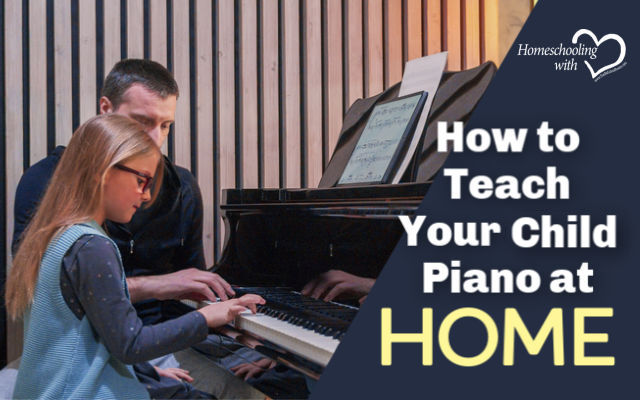How to Teach Piano to Your Child at Home


Like many things, having your child learn an instrument is easier said than done. Traditional lessons are expensive, time-dependent, and all too often too far away from home to be viable.
It doesn’t have to be this difficult though; in fact, many parents have found a way to teach piano at home to their child. Not only is this generally more cost effective, it’s also far more convenient – you don’t even have to leave your home!
Not only are there numerous benefits of learning an instrument at an early age, but it’s also a great way to break up the day and add some creative focus to your homeschool routine.
Learning an instrument takes some dedication and focus though. If you’re interested in learning how to teach piano to your child at home, then you should know these 6 tips inside and out.
6 Tips for Teaching Your Child to Play Piano at Home
If You Don’t Have Experience Playing Piano, Opt for Online Lessons
When learning piano at home, your child has two major options. The first is to learn from a book. Many piano teachers employ this method, and it can be a great way to guide new learners through the process of learning about the different components of a piano, before progressing onto learning about different notes and eventually onto playing songs.
The trick here is that children often need a teacher or mentor to help them understand the content of piano books. If you yourself are or have been a piano player, then great! If not, you might be better off going for online piano lessons.
There are a number of sites providing online lessons, often using video format to provide informative guidance and support to learners.
Consider Learning Alongside Them
One of the best ways to help your child learn piano at home is to learn how to play yourself!
Not only does this give you an in-depth understanding of where they are at and what they are going through, but it will also make practice time more likely to happen as you can encourage each other.
If you aren’t interested in learning piano, you should at least educate yourself about the instrument so you can have some quality conversations with your child, answer any questions they might have, and generally support their learning journey.
Listen-In While They Are Practicing
A great way to support your child’s development is to listen-in as they practice new skills. This doesn’t mean you have to be looking over their shoulder every time they sit in front of the piano, but being within listening distance, at least, gives you an opportunity to hear them develop and deliver praise or to identify parts where they are getting stuck and offer support and advice.
Make It Fun for Them
Learning piano can be pretty repetitive. Your child is developing new fine motor skills as well as abstract concepts, and these can take a little while to grasp.
To avoid them getting bored and disinterested, try making little games out of the techniques they are learning. Alternatively, guide them to compose their own piece and even write it out.
Set an Appropriate Time for Lessons and Practice
Finding a good time for lessons and practice sessions is vital to teaching piano to your child at home. Just before dinner, for example, probably isn’t going to be a good time as they are likely to be distracted by hunger.
For homeschooled children, the middle of the day can be a great time for practice, breaking up more academic lessons with a creative activity. Whatever time you choose, stick to it. Routine is extremely important when learning a new instrument.
Listen to Piano Music
Unfortunately, piano is an instrument that doesn’t feature in a lot of mainstream music.
When your child first picks up piano lessons, chances are they’ll be spending the first few weeks or even months learning basic techniques such as finger positioning, note names, and how to read music. This can create a disconnect between their understanding of the instrument and how it can actually be applied.
Encourage your child to continue by listening to piano-based music with them. This doesn’t have to be a complex Beethoven symphony; even simple piano tunes can help them understand the skillset they are working toward. Having these goals in mind makes it easier to contextualize lessons and techniques learned as well as keeping motivation up.
Why Not Both?
The truth is, piano teachers exist for a reason. Learning an instrument on your own is tough, and what’s really valuable about in-person lessons is the teacher’s ability to recognize performance issues and provide correction.
Unfortunately, neither books nor online lessons can provide that level of feedback. So, if you have the option, why not pair in-person lessons with some learning at home?
Rebecca Marlow is a staff writer for Know Your Instrument and has been writing about learning instruments as both a child and an adult for the past five years. When not writing about or playing instruments, Rebecca likes to go horse riding and visiting the coast.













































